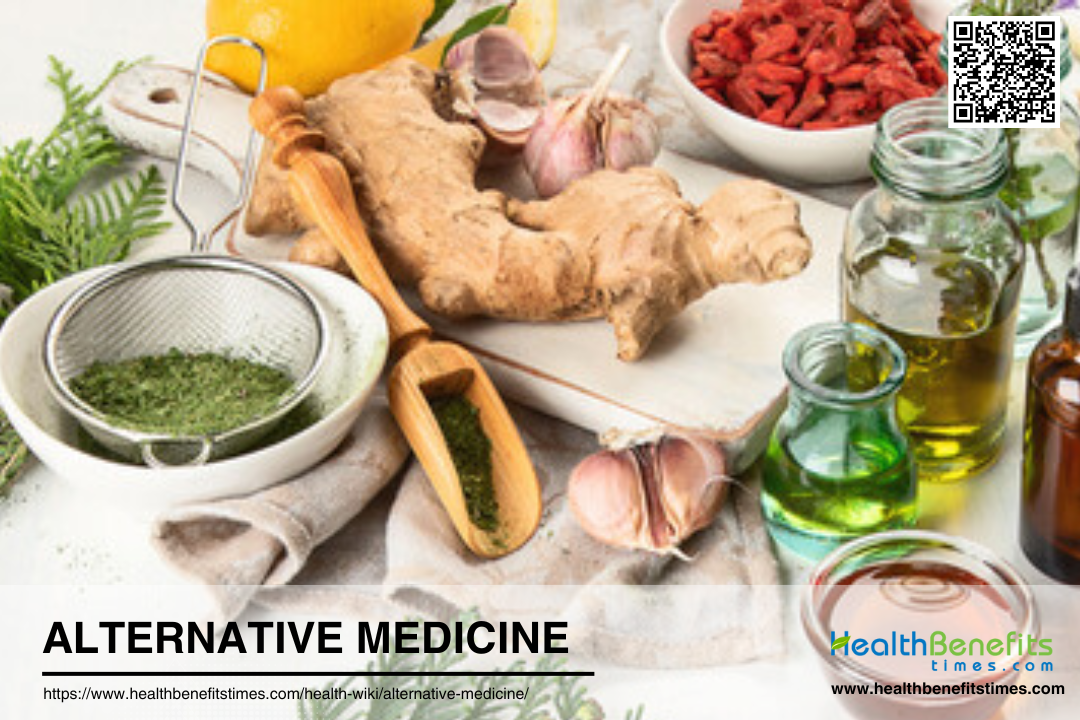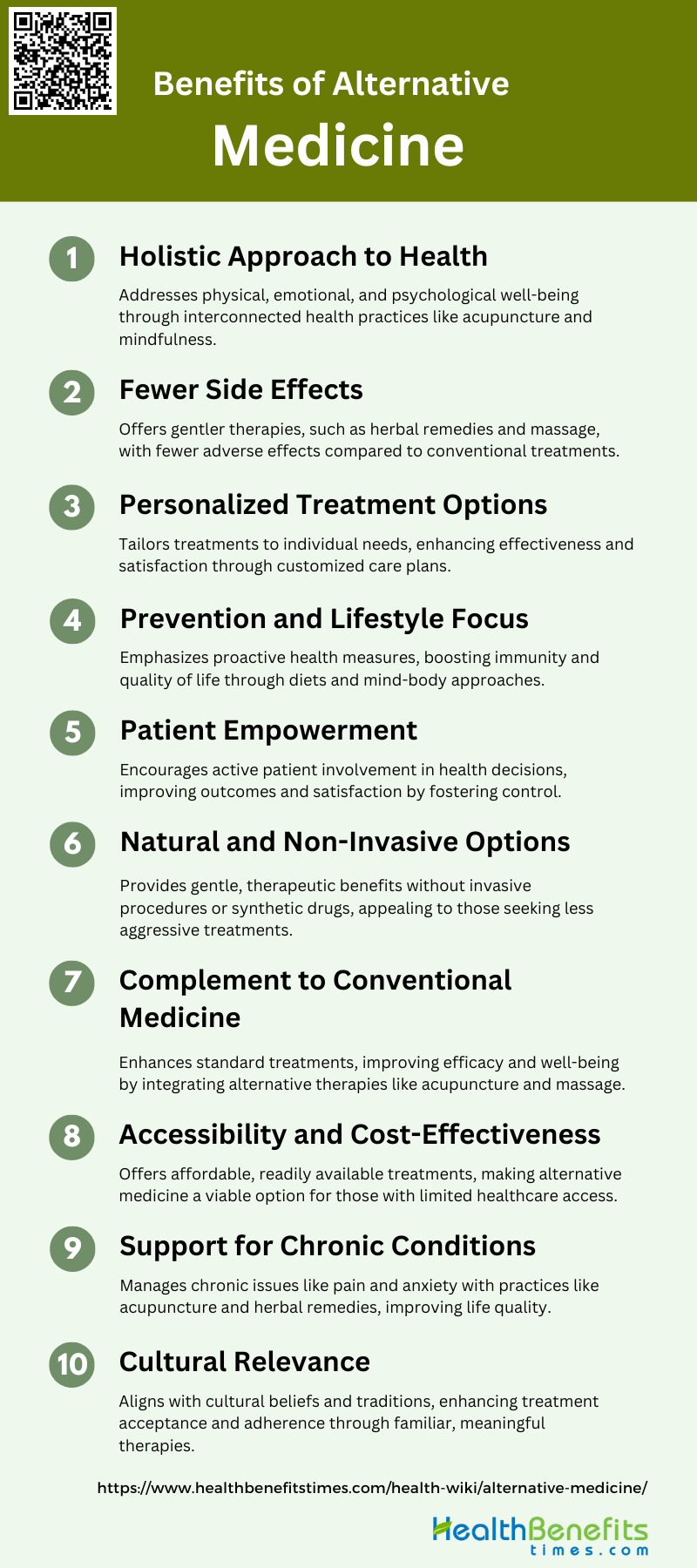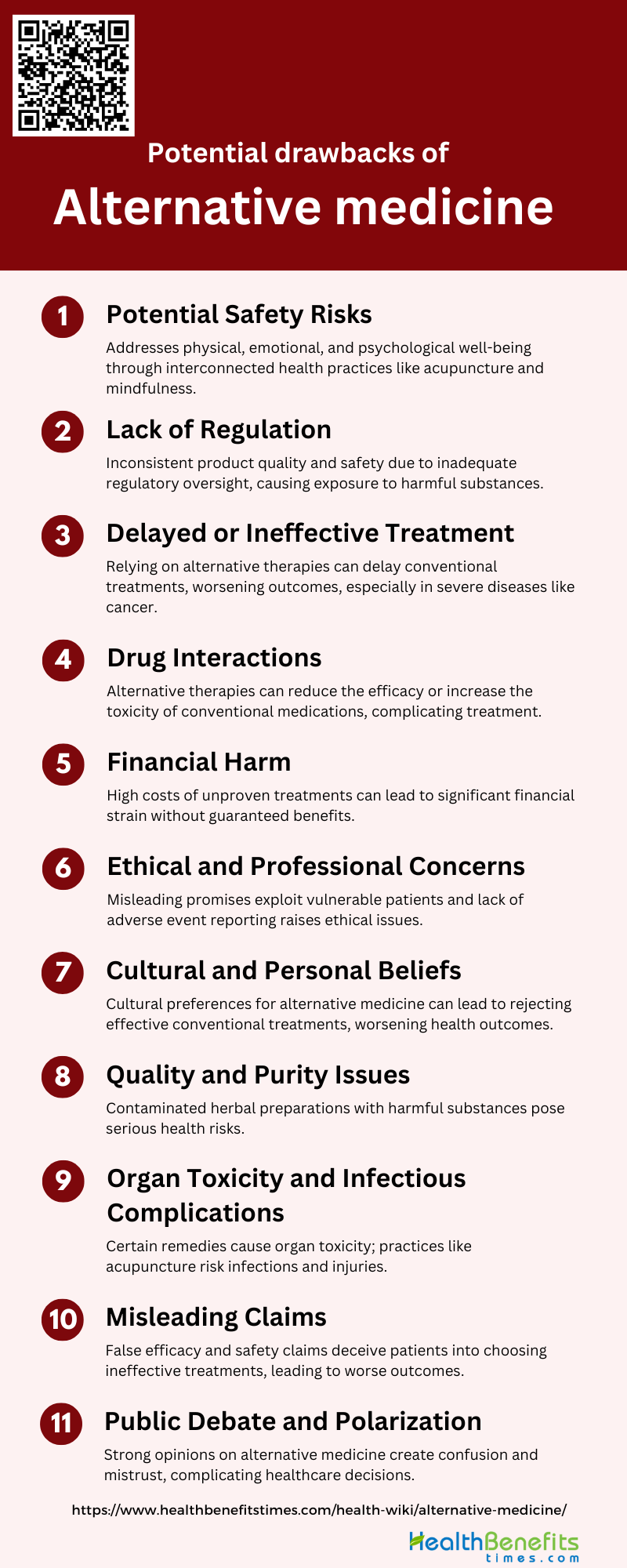Alternative medicine refers to a diverse range of medical practices and products that are not typically part of conventional Western medicine. These practices include, but are not limited to, herbal remedies, acupuncture, chiropractic care, and homeopathy. Unlike complementary medicine, which is used alongside conventional treatments, alternative medicine is often used in place of standard medical practices. The use of alternative medicine is driven by various factors, including cultural beliefs, personal preferences, and dissatisfaction with conventional treatments. Despite its popularity, especially among patients with chronic conditions or those seeking holistic approaches, the efficacy and safety of many alternative treatments remain subjects of ongoing research and debate within the medical community
Types of Alternative Medicine
These methods often focus on holistic approaches to health and wellness, emphasizing the connection between mind, body, and spirit. Below are some common types of alternative medicine:
1. Acupuncture: An ancient Chinese practice involving the insertion of thin needles into specific points on the body to balance energy flow and treat various conditions.
2. Ayurveda: A traditional Indian system of medicine focusing on balancing the body, mind, and spirit through diet, herbal remedies, and lifestyle changes.
3. Homeopathy: A medical system based on the principle of “like cures like,” using highly diluted substances to trigger the body’s natural healing processes.
4. Naturopathy: A holistic approach to health that emphasizes natural treatments, including diet, exercise, and herbal medicine, to support the body’s ability to heal itself.
5. Traditional Chinese Medicine (TCM): A comprehensive medical system that includes acupuncture, herbal medicine, massage, and dietary therapy to restore balance and harmony in the body.
6. Chiropractic: A treatment method focusing on diagnosing and treating musculoskeletal disorders, particularly through spinal manipulation and adjustments.
7. Herbal Medicine: The use of plants and plant extracts to treat various health conditions and promote overall well-being.
8. Reflexology: A therapeutic method involving the application of pressure to specific points on the feet, hands, or ears to promote healing in corresponding parts of the body.
9. Reiki: A Japanese energy healing technique that involves the practitioner transferring healing energy to the patient through hands-on or hands-off methods.
10. Yoga: A practice combining physical postures, breathing exercises, and meditation to promote physical, mental, and spiritual health.
11 Meditation: A practice of focused attention and mindfulness to achieve a state of mental clarity, relaxation, and emotional well-being.
12. Aromatherapy: The use of essential oils and aromatic plant extracts to promote physical and psychological health through inhalation or topical application.
13. Massage Therapy: The manipulation of soft tissues in the body to relieve pain, reduce stress, and improve overall health.
14. Biofeedback: A technique that teaches individuals to control physiological processes such as heart rate and muscle tension through real-time feedback.
15. Hypnotherapy: The use of guided relaxation and focused attention to achieve a heightened state of awareness and address various psychological and physical conditions.
Benefits of Alternative Medicine
Alternative medicine offers a variety of benefits that can complement traditional medical treatments. It emphasizes holistic care, focusing on the mind, body, and spirit, and often utilizes natural remedies and therapies. Here are some key benefits of alternative medicine:
1. Holistic Approach to Health
This approach can lead to a more comprehensive understanding of health and wellness. For instance, practices such as acupuncture, reflexology, and mindfulness training are designed to address not just physical symptoms but also emotional and psychological well-being. This holistic perspective can help patients develop a more balanced and integrated approach to their health.
2. Fewer Side Effects
One of the significant advantages of alternative medicine is the potential for fewer side effects compared to conventional treatments. Many alternative therapies, such as herbal remedies, acupuncture, and massage, are perceived to be gentler on the body. For example, patients using CAM for chronic pain, anxiety, and insomnia have reported fewer adverse effects compared to those using conventional medications. This can be particularly beneficial for individuals who are sensitive to the side effects of pharmaceutical drugs.
3. Personalized Treatment Options
Alternative medicine often offers personalized treatment plans tailored to the individual’s unique needs and conditions. This customization can lead to more effective and satisfactory outcomes. For example, CAM practices like homeopathy and naturopathy focus on individualized assessments and treatments, which can be more aligned with the patient’s specific health concerns and lifestyle. This personalized approach can enhance the overall effectiveness of the treatment.
4. Prevention and Lifestyle Focus
Many alternative medicine practices emphasize prevention and lifestyle changes as key components of health care. This proactive approach can help individuals maintain better health and prevent the onset of diseases. For instance, CAM modalities such as special diets, nutrition, and mind-body approaches are often used to boost the immune system and improve overall quality of life. By focusing on prevention, alternative medicine can contribute to long-term health and well-being.
5. Patient Empowerment
This sense of control and participation can lead to better health outcomes and increased patient satisfaction. For example, cancer patients using CAM reported higher levels of benefit finding and a sense of control over their health. This empowerment can enhance the patient’s motivation and commitment to their treatment plan.
6. Natural and Non-Invasive Options
Many alternative medicine practices utilize natural and non-invasive methods, which can be appealing to those seeking less aggressive treatments. Techniques such as herbal medicine, acupuncture, and yoga offer therapeutic benefits without the need for invasive procedures or synthetic drugs. These natural options can be particularly attractive to individuals looking for gentler ways to manage their health conditions.
7. Complement to Conventional Medicine
Integrating CAM with standard medical practices can enhance treatment efficacy and patient well-being. For instance, CAM therapies like acupuncture and massage are often used alongside conventional treatments to manage pain and anxiety in cancer patients. This complementary approach can lead to improved health outcomes and patient satisfaction.
8. Accessibility and Cost-Effectiveness
Alternative medicine can be more accessible and cost-effective compared to conventional treatments. Many CAM practices are less expensive and more readily available, making them an attractive option for individuals with limited access to traditional health care. For example, the use of CAM in managing migraines and severe headaches has been associated with improved health-related quality of life outcomes at a lower cost. This accessibility can make alternative medicine a viable option for a broader population.
9. Support for Chronic Conditions
Practices such as acupuncture, herbal remedies, and mind-body techniques have shown promise in treating chronic pain, anxiety, and other long-term health issues. For instance, individuals with serious mental illness have reported perceived benefits from using alternative health care practices as part of their mental health recovery. This support can be crucial for individuals dealing with persistent health challenges.
10. Cultural Relevance
Traditional therapies such as Ayurveda, Chinese medicine, and herbal remedies are deeply rooted in cultural traditions and can resonate with patients’ values and beliefs. This cultural relevance can enhance the patient’s connection to their treatment and improve adherence to the therapeutic regimen.
Criticism and Controversies of Alternative medicine
Critics argue that many alternative treatments lack scientific validation and can sometimes lead to harmful consequences. Below are some common criticisms and controversies associated with alternative medicine:
1. Lack of Scientific Evidence
One of the primary criticisms of alternative medicine is the lack of robust scientific evidence supporting its efficacy. Many alternative treatments have not undergone rigorous randomized controlled trials (RCTs), which are the gold standard in conventional medicine. For instance, homeopathy, a popular alternative therapy, has been extensively studied, yet meta-analyses often conclude that its effects are no better than placebo. This lack of evidence makes it difficult for practitioners to recommend these treatments confidently, leading to skepticism within the medical community.
2. Safety Concerns
Safety is a significant concern when it comes to alternative medicine. Adverse effects from treatments such as herbal medicine and acupuncture are well-documented. For example, injuries from acupuncture needles and severe complications from chiropractic manipulations have been reported. Additionally, the use of unregulated herbal supplements can lead to adverse drug reactions, posing serious health risks to patients. These safety issues highlight the need for stringent regulatory oversight and proper training for practitioners of alternative medicine.
3. Opposition from Conventional Medical Practitioners
Conventional medical practitioners often oppose alternative medicine due to its perceived lack of scientific rigor and potential to mislead patients. This opposition is rooted in the belief that alternative treatments can divert patients from evidence-based medical care, potentially leading to harm. The medical community’s skepticism is further fueled by the fact that many alternative therapies, such as homeopathy, defy established scientific principles, making it challenging to integrate them into conventional medical practice.
4. Methodological Challenges
Many studies on alternative treatments suffer from poor design, small sample sizes, and lack of proper blinding and randomization. These methodological flaws make it difficult to draw definitive conclusions about the effectiveness of alternative therapies. For instance, studies on homeopathy often show positive results due to inadequate blinding and small sample sizes, leading to questions about the validity of these findings.
5. Regulatory Issues
The regulation of alternative medicine varies widely across different countries, leading to inconsistencies in the quality and safety of treatments. In many regions, alternative therapies are not subject to the same rigorous regulatory standards as conventional medicine, resulting in a lack of oversight and potential for harm. This regulatory gap allows unqualified practitioners to offer treatments, further exacerbating safety concerns and undermining public trust in alternative medicine.
6. Potential for Harm
The potential for harm is a critical issue in alternative medicine. Delayed diagnosis and treatment due to reliance on alternative therapies can lead to serious health consequences, including disease progression and death. For example, cancer patients in less developed countries who opt for alternative treatments often experience significant delays in receiving conventional care, resulting in advanced disease stages and poorer outcomes. This highlights the need for better education and regulation to prevent such harmful practices.
7. Economic Exploitation
Economic exploitation is another controversy surrounding alternative medicine. The high cost of alternative treatments, often not covered by insurance, can lead to significant financial hardship for patients. In some cases, practitioners may exploit vulnerable patients by offering false promises of cure, leading to unnecessary expenditure on ineffective treatments. This exploitation underscores the need for ethical guidelines and consumer protection measures in the alternative medicine industry.
8. Placebo Effect
The placebo effect plays a significant role in the perceived efficacy of alternative medicine. Many alternative treatments may work primarily through the placebo effect, where patients experience improvements in their condition due to their belief in the treatment rather than the treatment itself. While the placebo effect can have genuine therapeutic benefits, it raises questions about the true efficacy of alternative therapies and whether they should be recommended over evidence-based treatments.
9. Ethical Concerns
Ethical concerns arise when medical practitioners prescribe alternative treatments that lack a solid evidence base. The principle of “do no harm” is central to medical ethics, and recommending unproven therapies can violate this principle. Additionally, misleading patients about the benefits of alternative treatments can erode trust in the medical profession and lead to poor health outcomes. These ethical dilemmas highlight the need for clear guidelines on the use of alternative medicine in clinical practice.
10. Integration with Conventional Medicine
Integrating alternative medicine with conventional medical practice presents both opportunities and challenges. While some alternative therapies may offer complementary benefits, their integration requires careful evaluation of their safety and efficacy. The lack of scientific evidence and regulatory oversight complicates this integration, making it essential to establish rigorous standards and guidelines for incorporating alternative treatments into mainstream healthcare.
11. Public Perception and Attitudes
Public perception and attitudes towards alternative medicine are influenced by cultural beliefs, dissatisfaction with conventional medicine, and the appeal of natural and holistic treatments. Despite the controversies, many people find alternative medicine persuasive and compelling due to its emphasis on personal responsibility, natural healing, and holistic care. Understanding these cultural and epistemological dimensions is crucial for fostering better communication and collaboration between conventional and alternative medical practitioners.
Potential drawbacks of alternative medicine
While alternative medicine offers various benefits, it is essential to consider its potential drawbacks. These can range from a lack of scientific validation to possible interactions with conventional treatments. Below are some key concerns associated with alternative medicine:
1. Potential Safety Risks
This alternative medicine can pose significant safety risks due to the lack of rigorous testing and standardization. For instance, herbal products may interact with prescription medications, leading to adverse effects. A notable example is the interaction between various herbs and warfarin, a blood thinner, which can increase the risk of bleeding or potentiate the drug’s effects. Additionally, the potential for organ toxicity, such as liver and kidney damage, has been documented with the use of certain herbal remedies.
2. Lack of Regulation
The alternative medicine industry often lacks stringent regulatory oversight, which can result in inconsistent product quality and safety. Many alternative therapies do not meet essential standards of consistency in composition and biological activity. This lack of regulation can lead to the presence of undisclosed over-the-counter or prescription drugs, contamination with pesticides and heavy metals, and errors in plant identification. Consequently, patients may be exposed to harmful substances without their knowledge.
3. Delayed or Ineffective Treatment
Relying on alternative medicine can delay the administration of conventional treatments, potentially leading to serious harm or even death. For example, cancer patients who opt for alternative therapies instead of conventional treatments like chemotherapy or surgery have been found to have a higher risk of death. In less developed countries, the delay in diagnosis and treatment due to the use of alternative medicine can result in advanced disease stages and poorer outcomes.
4. Drug Interactions
Alternative therapies can interact with conventional medications, leading to reduced efficacy or increased toxicity. For instance, herbal products such as ginseng and green tea have been associated with interactions with warfarin, complicating anticoagulant therapy. These interactions are often underreported due to a lack of professional surveillance, making it difficult to assess their clinical significance.
5. Financial Harm
The use of alternative medicine can lead to significant financial harm, especially when patients spend large sums on unproven treatments. The global expenditure on alternative medicines exceeds one billion dollars annually, which is comparable to the amount spent on cancer research. In some cases, patients may experience financial hardship due to the high costs of alternative therapies, which may not provide the promised benefits.
6. Ethical and Professional Concerns
The promotion and use of alternative medicine raise ethical and professional concerns, particularly when false promises of guaranteed cures are made. This can exploit vulnerable patients seeking less invasive treatments or remedies for hopeless cases. Additionally, the lack of professional surveillance and reporting of adverse events further complicates the ethical landscape of alternative medicine.
7. Cultural and Personal Beliefs
Cultural and personal beliefs can strongly influence the use of alternative medicine, sometimes leading to the rejection of conventional treatments. In some regions, local religious beliefs and practices encourage the use of non-conventional treatments, which can delay or replace effective medical interventions. This cultural inclination towards alternative medicine can result in poorer health outcomes and increased suffering.
8. Quality and Purity Issues
The quality and purity of alternative medicine products are often questionable due to the lack of regulation. Herbal preparations can be contaminated with harmful substances such as pesticides, heavy metals, and adulterants like steroids. These contaminants can pose serious health risks, including organ toxicity and allergic reactions, further complicating the safety profile of alternative therapies.
9. Organ Toxicity and Infectious Complications
Organ toxicity and infectious complications can be caused by alternative medicine. For example, certain herbal remedies have been associated with liver and kidney toxicity, while acupuncture has been linked to mechanical injuries and infections such as hepatitis and bacterial endocarditis. These adverse effects highlight the need for caution and professional oversight when using alternative therapies.
10. Misleading Claims
Misleading claims about the efficacy and safety of alternative medicine can deceive patients into choosing ineffective treatments. False promises of guaranteed cures and the portrayal of alternative therapies as less toxic and invasive can lead patients to forego conventional treatments, resulting in worse health outcomes. It is crucial for patients to be well-informed and for healthcare providers to guide them in making evidence-based decisions.
11. Public Debate and Polarization
The use of alternative medicine often sparks public debate and polarization, with strong opinions on both sides. Proponents argue for the benefits and holistic approach of alternative therapies, while critics emphasize the lack of scientific evidence and potential risks. This polarization can create confusion and mistrust among patients, complicating their healthcare decisions and potentially leading to suboptimal treatment choices.





